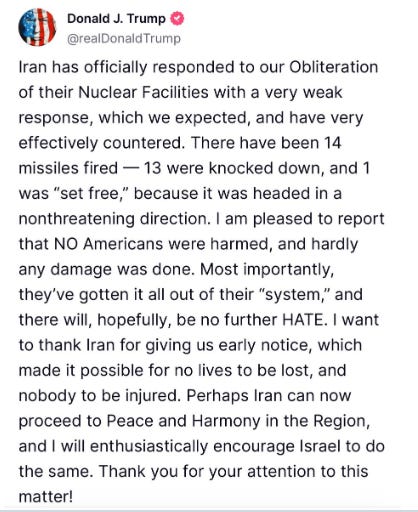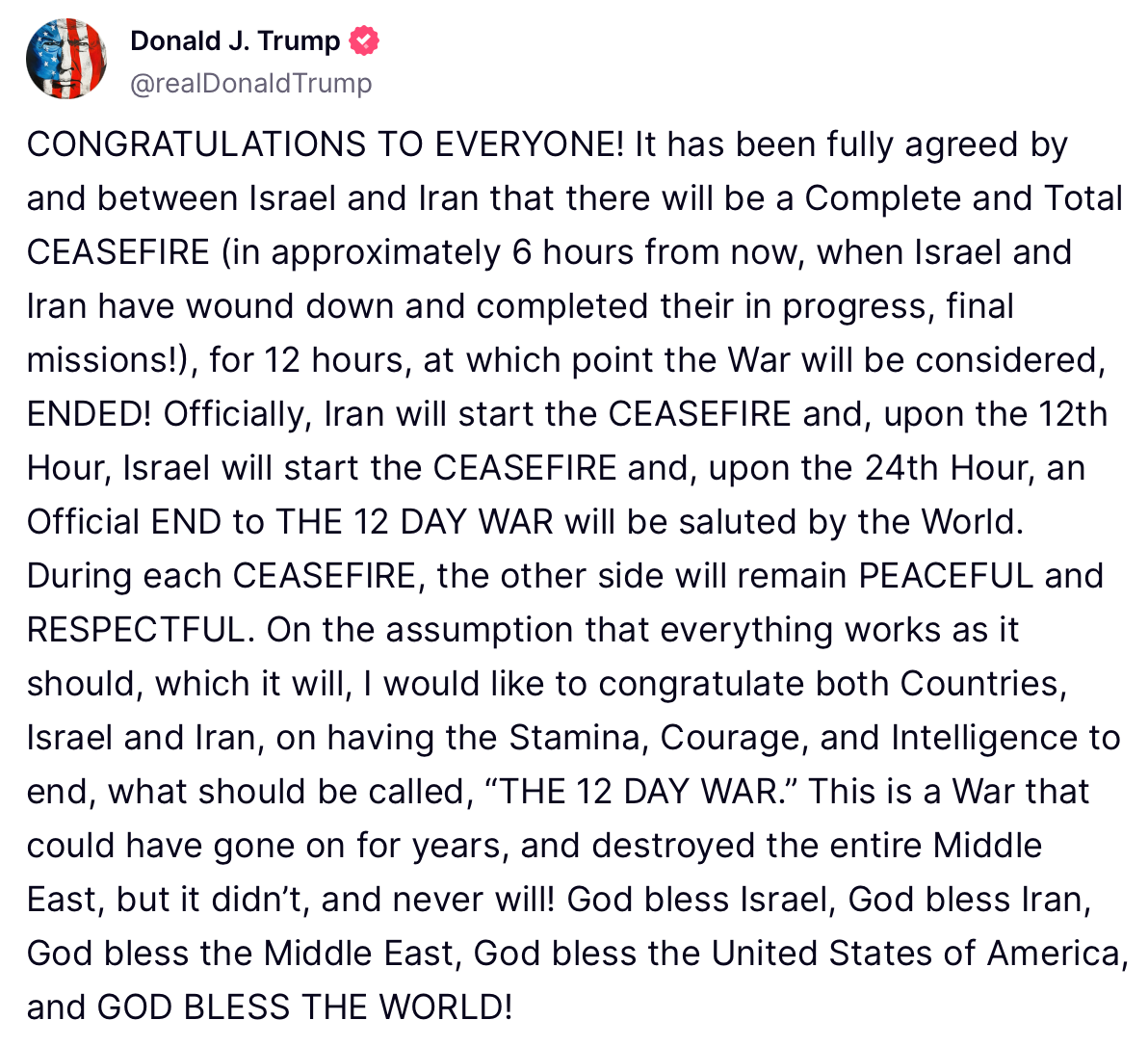The attacks on Iran – illusions and delusion
The US attack on Iran was unwitnessed. There are no videos on the internet of the actual bombings, though we have official defense department videos of the seven B-2 bombers taking off and then landing 37 hours later. We have evidence of what took place, pictures of holes and ash in the mountains at Fordow, Natanz and Eshafan.
What would take place afterwards was the subject of speculation. Would Iran reply as it did after the 2020 assassination of General Soleimani and after the October 2024 bombings by Israel, when its response was more symbolic? In both cases, Iran apparently telegraphed its intentions to the US, to avoid the killing of American soldiers (apparently it is acceptable to kill Iranians, but if one American is killed, “hell hath no fury…”). Or would Iran reply with a serious attack on American bases throughout the Middle East?
The answer arrived on Monday the 23rd. Iran launched 19 missiles against the American Al Udeid base in Qatar, only one of which hit the base. There were no casualties as the US had already moved its planes from Quatar to Prince Dulta airfield before the attack and had sheltered its soldiers. Donald Trump confirmed the attack was scripted and posted his thanks to Iran for warning about the attack and expressed hope for a peaceful resolution.
Thus it may be that both sides were choreographing the response, a response necessary in order to save face, in order to de-escalate the conflict.
What then of the US attack? This was widely telegraphed. In the days before the attack X posted maps of the eastward flight of most of the US Air Force refuleing airplanes. Widely reported was that Trump would make a decision to attack Iran within 2 weeks. It took him only 2 days to launch the attack.
In an operation titled “Midnight Hammer” 7 B-2 bombers flew from Missouri and dropped 12 bunker-busters (30,000 pound bombs officially called GBU-57 Massive Ordnance Penetrators) on Fordow and two on Natanz. Isfahan and Natanz nucleur sites were attacked just before the bombings by 24 Tomahawk missiles fired from asubmarine. Joint Chiefs of Staff general Dan Caine said that Iran’s Tehran's "fighters did not fly," and its "surface-to-air missile systems did not see us.”
There was an attempt at deception in the mission (but who were they trying to fool?) as a number of B-2 stealth bombers flew westward from Missouri toward Guam as decoys, while the real strike package flew east in stealth mode, refuleing multiple times en route.
Was Iran forewarned about the US attack? There is one report dated June 21 that Iran was notified of the US attacks via a third party and that they would target the three nuclear sites but that the US did not seek all-out war. The forewarnings may shed light on the reason why US airplanes were not fired on. This is consistent with Trump saying that the enemy was not Iran but the Nucleur program. If true (and I have not yet found corroboration), one can thus see Trump’s one-off bombing of Iran’s nucleur facilities and Iran’s reciprocal bombing of a US base as face-saving ways to appease their bases and de-escalate the conflict.
Then on Monday the 23rd Trump announced a ceasefire between Israel and Iran, that Iran said it would observe if Israel stopped its attack.
Israel agreed, but as always within hours it had violated the cease fire with its heaviest attack to date on Tehran. Trump in a statement June 24 criticized both sides but especially Israel, saying ““Israel, as soon as we made the deal they came out and they dropped a load of bombs, the likes of which I’ve never seen before. The biggest load that we’ve seen…I’m not happy with Israel. You know, when I say, ‘OK now you have 12 hours,’ you don’t go out to the first hour, just drop everything you have on, so I’m not happy with them. I’m not happy with Iran either.” Trump continued his censure in a Truth Social post that appeared shortly after, all caps are his.
“ISRAEL. DO NOT DROP THOSE BOMBS. IF YOU DO IT IS A MAJOR VIOLATION. BRING YOUR PILOTS HOME, NOW!”
One can only hope that this desire for a ceasefire is genuine and not a deception like the previous negotiations.
In response President Masoud Pezeshkian stated that “Iran will not violate the ceasefire, unless the Zionist regime does,” “Tehran is ready for talks and to defend the rights of the Iranian people at the negotiation table.”
One can speculate about the role of Russia in de-escalating the tension. On the 23rd Iran Foreign Minister Abbas Araghchi met in Moscow with Putin, Russian Foreign Minister Sergei Lavrov and military intelligence (GRU) chief Igor Kostyukov. Hours later Iran made its symbolic retaliatory strike. Trump later revealed on the 24th June that Putin had called him to offer help on the Iranian conflict. Russia’s concern here is potential instability on its southern border as it fights a war on its western border.
Why did Israel agreed to a ceasefire, even as it was boasting that it controlled Iran’s airspace and could bomb at will? First, it is likely that Israel was limited in its invasion of Iranian airspace. Reports indicate that much of its missiles were fired from Syrian and Iraqi airspace (casting retrospective light on why Israel attacked and destroyed the Syrian airforce after the al-Qaeda takeover.) Much of the initial damage was done from drone bases inside Iran that Israel (no doubt with the awarenes of US intelligence) had prepared for years. Israel used car bombs to kill targeted military and scientists, and there were rumors about the use of rebel separatist groups within Iran.
More importantly, The answer may lie in the severity of the Iranian response to Israel’s attack. Far more missiles than anticipated were evading Israel’s defense and landing on targets in Israel. Israel in its hubris put great fate in its Iron Dome, despite indications of its vulnerability in the October 2024 exchange of missiles. Part if it is a question of math—Iran has more missiles and drones than Israel has defensive missiles. Further, these offensive weapons cost far less than defensive missiles, with a $100,000 drone requiring one or two multi-million dollar missiles to intercept. $35,000 drone vs million dollar interceptor: this is the asymmetry between aerial offense and defense in the current drone era. Between Iran’s decoy projectiles and real missiles, Israel’s defenses were overwhelmed both acutely and long term, with Israel simply running out of missiles. As it was, Iran’s attacks on Ben-Gurion airport and other airbases forced Israel to divert some of its planes to British bases in Cyprus. The longer the war lasts, the more the Iranian advantage in a war of attrition, which is why Israel is so desperate to entangle the US.
The war is costing Israel hundred of millions of dollars a day, a pace that is sutainable for a weeks but not months. Iran’s counterattacks to Israel’s aggression are heavily damaging Israel’s infrastructure, particularly its air and sea bases for trade with other countries. Ben-Gurion international airport was closed for days and is now open for very limited flights. Much of the economy is shut down with only essential workers called in. Much of the country shelters in bomb shelter during missile attacks (In this they are far more fortunate than Palestinians in Gaza, who face Israeli air attacks sheltered only in tents.) Emigration from Israel is growing.
The situation on the ground in Israel is not well known, as Israel requires that news organizations “obtain prior written approval from [Israel’s] military censor for any broadcast from Israel during wartime, including its location.” It has recently banned international news organizations such as al-Jazeera, Reuters and AP from broadcasting from Israel.
What about the role of the International Atomic Energy Commission (IAEA)? The commission as it should condemned attacks on nucleur installations, pointing out that “any armed attack on and threat against nuclear facilities devoted to peaceful purposes constitutes a violation of the principles of the United Nations Charter, international law and the Statute of the Agency”.
A day previously, however, in the midst of tensions about an imminent Israeli and/or US attack on Iran, the IAEA had released a statement criticizing Iran for not fully providing information to the agency about its uranium enrichment dating back before 2003. This was in turn based on a report made 2 weeks prior. This complaint about Iran’s enrichment activities prior to 2003 was triggered by a 2018 Mossad report that itself has been challenged as a false flag operation. Why the IAEA would release such a report resurrecting complaints about events that happened over 22 years ago, in the midst of tensions about an imminent Israeli and/or US attack on Iran, gives credence to the accusation that it was made to provide justification for the illegal attack by Israel, a country that is not a party to the nucleur non-proliferation treaty or to any agreement with Iran. A few days after the report, documents were published showing communication between Tel Aviv and the head of IAEA, Rafael Grossi. These included giving to Israel the names of Iranian nucleur scientists, many of whom were subsequently assassinated by Israel.
What comes next is unclear. The track record of Israel fulfilling its agreements is very consistent: Israel will not comply. One has only to look at the Lebanon “ceasefire” and the Gaza “agreements”. One likely scenario is that Israel uses the ceasefire as an opportunity to re-arm and then to resume its attacks. It is delusional to think that the US and Europe will not assist Israel in this. Attack is what Israel knows best and is almost the sole behavior in its repertoire.
On the other hand Israel’s perceived immunity is gone, the Israeli economy is a shambles and many of its citizens are emigrating. This will leave it with a higher proportion of right wing extremists and little hope of ending its expansionist self-image.
As for the US, the attack on Iran can be seen in the context of General Wesley Clark’s revelations of the post 9/11 US plan to overthrow 7 Muslim countries in 5 years, starting with Iraq, Syria, Lebanon, Libya, Somalia, and Sudan, culminating in Iran. It is not at all clear that Iran has been significantly set back in case it decides to create a nucleur bomb. If not, then there are few other options, mainly using nucleur weapons or invading Iran with “boots on the ground”. Neither are attractive options for a president who plays with the idea of receiving a Nobel Peace Prize.
The US lauds itself on its strategic deception. Per Mark Kimmitt, a former deputy director at Centcom, “The ultimate deception was Trump laying down a two-week timeline for negotiations and then attacking Iran three days later, a classic Trojan horse.” The US had also attempted to dupe Tehran with negotiations before the first Israeli attack. The problem of course is that any US credibility that somehow still existed, has been destroyed. Who would trust its diplomacy?
As for Europe and the G7, by their emphasis on Israel’s “right to self-defense” without condemning Israel’s aggression, they have tied their lot to that of the US and Israel. They too have lost their credibility with the rest of the word.
The message to the rest of the world? It is starkly laid out by Arnaud Bertrand.




The whole Israel/Iran 12-Day War thing struck me as a blatant piece of political theater.
I wouldn't be at all surprised when the dust settles to find out Bibi & the Khomini had been burning up those back-channel phone lines, maneuvering to get Trump that Nobel Peace Prize he so covets.